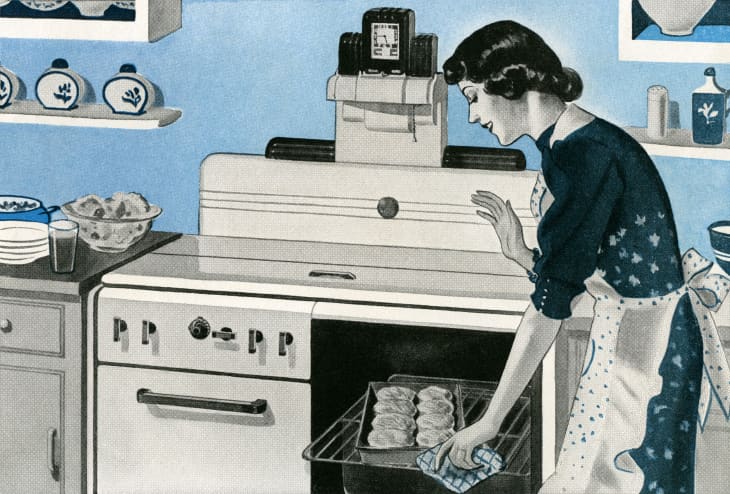Ever Wonder Why Today’s Kitchens Look the Way They Do?

The 1900s through the 1920s was a time of tremendous change in the kitchen, but it wasn’t until the 1930s that the kitchen began to take on its modern shape. The kitchen configuration that we all know now, has its roots, like a lot of modern design, in the German school known as the Bauhaus.
As I mentioned in my last post, on the design of the kitchen from 1900 through the 1920s, before the 1930s many kitchens had very little by way of built-in storage or workspace at all. A house might come equipped with a sink, stove, and perhaps a china cabinet, and the homeowner had to provide the rest. There was a booming trade in freestanding kitchen cabinets, which provided both storage and workspace. Even in the 1920s, when builders started adding built-in cabinets to kitchens, countertop heights were far from standardized, and you’d often see multiple heights in the same kitchen.
Compared to the kitchens of the 20s, 30s kitchens looked remarkably like their modern cousins. In this 1930s kitchen (also lead image above), spotted on Antique Home Style, built-in cabinets are surmounted by uninterrupted stretches of countertop. Stove and sink are integrated into the countertop (along with some nifty cutting board storage that I wouldn’t mind having in my own house).
A few factors helped contribute to the development of the kitchen as we know it now. The kitchen, once the domain of servants, began to attract the attention of designers as domestic help became less common and middle-class women began to spend more time in their kitchens. At the same time, there was an increased focus on efficiency. Applying techniques from industrial production could, it was thought, streamline kitchen labor and allow women to spend less time on work. And increasing industrialization made it possible, and even desirable, for appliances and cabinets to be manufactured at standardized heights.
Christine Frederick, whose book Household Engineering: Scientific Management in the Home was published in 1919, was an early proponent of efficiency in the home. Her suggestions for kitchen design were focused not on improving the kitchen’s look, but its function — for example, placing dish cupboards right next to the sink to save steps while putting things away. A few years later, Lillian Gilbreth, an engineer and psychologist who had worked on motion studies aimed at increasing the efficiency of industrial processes, turned her attention to the kitchen. She developed the idea of the ‘work triangle’ (composed of sink, refrigerator, and stove), which still guides kitchen design today.
The ideas of these two women were influential on a generation of German designers, who, fueled by their mania for clean, honest designs that clearly proclaimed their function, sought to create a kitchen that not only worked efficiently but looked efficient as well. In 1923, George Muche and Adolf Meyer, two designers at Germany’s modernist Bauhaus school, created the Haus am Horn, a model home whose kitchen, though it’s nearly 100 years old, looks strikingly modern. It’s all there: the smooth, level countertops, the uniform cabinets, the stove that tucks neatly under the counter.
In 1927, Margarete Schutte Lihotzky, the first woman to qualify as an architect in her native Austria, built on and expanded upon the ideas of the Bauhaus kitchen with her design for the Frankfurt kitchen, designed for the new worker housing being built in that city. The Frankfurt kitchen, though quite small, was full of thoughtful touches designed to ease the burden of homekeeping, including a fold-out ironing board, a wall-mounted dish drainer, and aluminum bins for dry goods, which had handles and spouts for pouring. The Frankfurt Kitchen was hugely influential on subsequent kitchen design: like the Bauhaus example, it seems preternaturally modern, although with a bit more warmth (and even color). Interestingly enough, the Frankfurt kitchen did not come with a refrigerator, thought to be an extravagance in a place where people still shopped every day.
In the 1930s, kitchen ads, if not necessarily actual kitchens, began to reflect the new vogue for the ‘fitted’ kitchen. In 1943 the Libbey-Owens-Ford company comissioned H. Creston Dohner to design a model kitchen, called the ‘Kitchen of Tomorrow’. Displayed in various department stores throughout the country, it was seen by an estimated 1.5 million people.
Although some of its innovations, like the built-in waffle maker and foot pedal-operated sink, didn’t quite catch on, the Kitchen of Tomorrow helped to establish the Bauhaus idea of sleek, continuous countertops as the standard for a modern kitchen. Of course, this didn’t mean that people went out and replaced their piecemeal kitchens immediately. But the die had been cast — the new look of the kitchen had been established, and there was no going back.
For further reading: